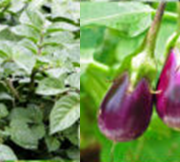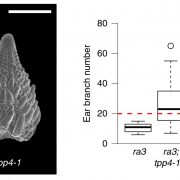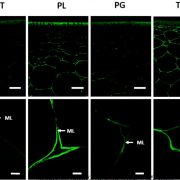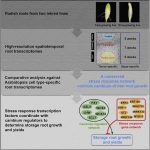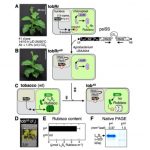Variation in maize chlorophyll biosynthesis alters plant architecture (Plant Physiol)
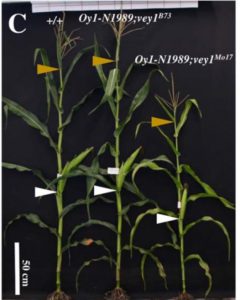 This is an interesting paper that combines classical genetics with biochemistry and phenotypic analysis. Khangura et al. looked at maize lines with various allelic combinations of two loci that affect chlorophyll biosynthesis: the oil yellow1 (oy1) gene encodes magnesium chelatase, the first committed step in chlorophyll production, and very oil yellow1 (vey1) is a cis-regulatory modifier. Because magnesium chelatase is a multimeric enzyme, some mutant alleles such as Oy1-N1989 behave in a semi-dominant manner. The vey1 modifier allele is a polymorphism of the oy gene that affects mRNA levels, but only is visible phenotypically in plants carrying the Oy1-N1989 allele. The authors found that these allelic interactions can lead to variations in the chlorophyll content of plants, and that the growth responses of the plants are affected by chlorophyll content. Some of these effects are straightforward (e.g., a decrease in stalk width and decreased branching are associated with less chlorophyll) and some less so (e.g., plant height). Double mutant analysis with various genes affecting branching patterns suggests that the chlorophyll concentration acts upstream of branch outgrowth, and the accompanying branching defects are presumably a consequence of decreased energy availability. (Summary by Mary Williams @PlantTeaching) Plant Physiol. 10.1104/pp.20.00306
This is an interesting paper that combines classical genetics with biochemistry and phenotypic analysis. Khangura et al. looked at maize lines with various allelic combinations of two loci that affect chlorophyll biosynthesis: the oil yellow1 (oy1) gene encodes magnesium chelatase, the first committed step in chlorophyll production, and very oil yellow1 (vey1) is a cis-regulatory modifier. Because magnesium chelatase is a multimeric enzyme, some mutant alleles such as Oy1-N1989 behave in a semi-dominant manner. The vey1 modifier allele is a polymorphism of the oy gene that affects mRNA levels, but only is visible phenotypically in plants carrying the Oy1-N1989 allele. The authors found that these allelic interactions can lead to variations in the chlorophyll content of plants, and that the growth responses of the plants are affected by chlorophyll content. Some of these effects are straightforward (e.g., a decrease in stalk width and decreased branching are associated with less chlorophyll) and some less so (e.g., plant height). Double mutant analysis with various genes affecting branching patterns suggests that the chlorophyll concentration acts upstream of branch outgrowth, and the accompanying branching defects are presumably a consequence of decreased energy availability. (Summary by Mary Williams @PlantTeaching) Plant Physiol. 10.1104/pp.20.00306



